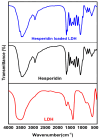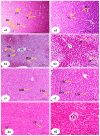Utilizing Nanoparticles of Hesperidin Loaded on Layered Double Hydroxide to Reduce Hepatotoxicity Caused by Paracetamol in Rats: Controlling of Biotransformation, Oxidative Stress, Inflammation, and Apoptosis
- PMID: 40284423
- PMCID: PMC12030007
- DOI: 10.3390/pharmaceutics17040429
Utilizing Nanoparticles of Hesperidin Loaded on Layered Double Hydroxide to Reduce Hepatotoxicity Caused by Paracetamol in Rats: Controlling of Biotransformation, Oxidative Stress, Inflammation, and Apoptosis
Abstract
Background/Objectives: The most used antipyretic and pain relief treatment is paracetamol (acetaminophen), also known as N-acetyl-para-aminophenol (APAP). However, it is considered potentially hazardous if consumed repeatedly in large doses or over prolonged periods. This investigation explores the effectiveness of hesperidin (Hesp) and Hesp loaded on layered double hydroxide nanoparticles (Hesp-NPs) in inhibiting the progression of acute hepatotoxicity in rats induced by APAP. Methods: LDH-Hesp-NPs were prepared and characterized. Male Wistar rats were orally treated with Hesp and Hesp-NPs at the same adjusted dose (100 mg/kg) every other day for six weeks. After 2 h of the first doses of Hesp and Hesp-NPs, the rats received one oral dose of APAP (750 mg/kg). Results: Administering of Hesp and Hesp-NPs to APAP-treated rats significantly reduced oxidant parameter (malondialdehyde) and serum enzymes (ALT, AST, LDH, and ALP) associated with liver function. Antioxidant markers in the liver, such as catalase and glutathione, also increased notably. Moreover, Hesp and Hesp-NPs enhanced the mRNA expression of liver UGT1A6, IL-10, and HO-1. Conversely, the mRNA expressions of liver CYP1A1, KEAP1, TGF-β, P53, and BAX decreased. These improvements in biochemical and molecular markers were corroborated by liver histopathology. Conclusions: Hesp and Hesp-NPs protect significantly against APAP-induced hepatotoxicity in male Wistar rats. Hesp-NPs treatment was more potent. The protective effects may be mediated via modulation of APAP biotransformation, oxidative stress, inflammation and apoptosis.
Keywords: hepatotoxicity; hesperidin nanoparticles; layered double hydroxide; paracetamol.
Conflict of interest statement
The authors declare no conflict of interest.
Figures














Similar articles
-
Dandelion polyphenols protect against acetaminophen-induced hepatotoxicity in mice via activation of the Nrf-2/HO-1 pathway and inhibition of the JNK signaling pathway.Chin J Nat Med. 2020 Feb;18(2):103-113. doi: 10.1016/S1875-5364(20)30011-X. Chin J Nat Med. 2020. PMID: 32172946
-
Effect of Hesperidin on Lipid Profile, Inflammation and Apoptosis in Experimental Diabetes.Dokl Biochem Biophys. 2025 Apr;521(1):198-205. doi: 10.1134/S1607672924601215. Epub 2025 Apr 11. Dokl Biochem Biophys. 2025. PMID: 40216721
-
Hesperetin attenuated acetaminophen-induced hepatotoxicity by inhibiting hepatocyte necrosis and apoptosis, oxidative stress and inflammatory response via upregulation of heme oxygenase-1 expression.Int Immunopharmacol. 2020 Jun;83:106435. doi: 10.1016/j.intimp.2020.106435. Epub 2020 Mar 26. Int Immunopharmacol. 2020. PMID: 32222641
-
The Preventive Effects and the Mechanisms of Action of Navel Orange Peel Hydroethanolic Extract, Naringin, and Naringenin in N-Acetyl-p-aminophenol-Induced Liver Injury in Wistar Rats.Oxid Med Cell Longev. 2019 Mar 26;2019:2745352. doi: 10.1155/2019/2745352. eCollection 2019. Oxid Med Cell Longev. 2019. PMID: 31049130 Free PMC article.
-
Therapeutic Potential of Plants and Plant Derived Phytochemicals against Acetaminophen-Induced Liver Injury.Int J Mol Sci. 2018 Nov 28;19(12):3776. doi: 10.3390/ijms19123776. Int J Mol Sci. 2018. PMID: 30486484 Free PMC article. Review.
References
-
- Halim A., Nur N.M., El-Agamy E.-S., Ibrahim A. Protective effect of hesperidin (HDN) on carbon tetrachloride (CCl4)-induced hepatic toxicity in male albino rats. AIJCR. 2017;8:20328–20338.
-
- Dart R.C., Bailey E. Does therapeutic use of acetaminophen cause acute liver failure? Pharmacotherapy. J. Hum. Pharmacol. Drug Ther. 2007;27:1219–1230. - PubMed
-
- Dar A., Saxena R., Bansal S. Hepatoprotection: A Hallmark of Citrullus colocynthis L. against Paracetamol Induced Hepatotoxicity in Swiss Albino Rats. Am. J. Plant Sci. 2012;3:1022–1027.
-
- Ahmed O.M. Natural Flavonoids: Chemistry, Therapeutic Potentials, Therapeutic Targets and Mechanisms of Actions. Curr. Pharm. Des. 2021;27:455. - PubMed
Grants and funding
LinkOut - more resources
Full Text Sources
Research Materials
Miscellaneous

